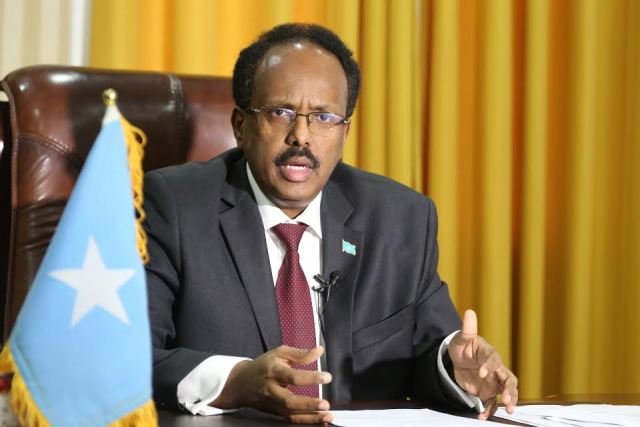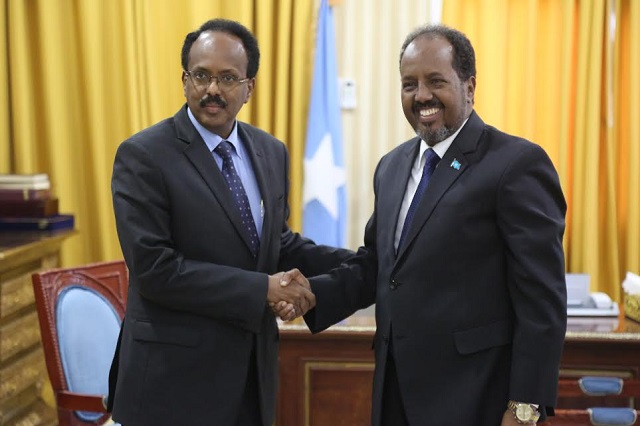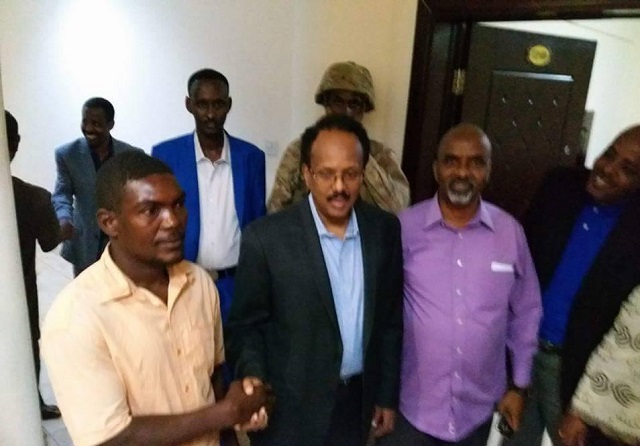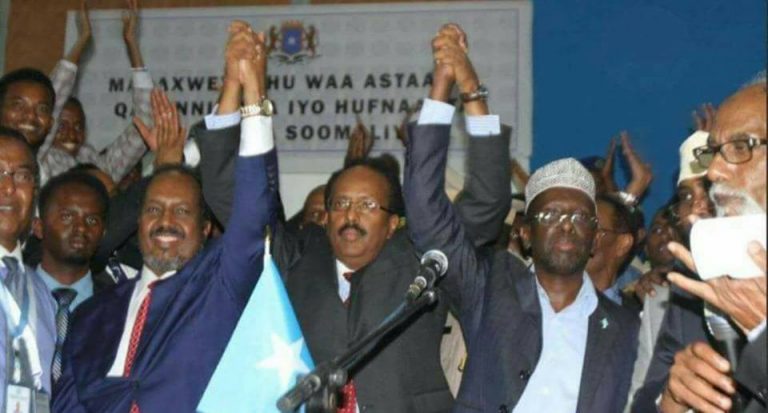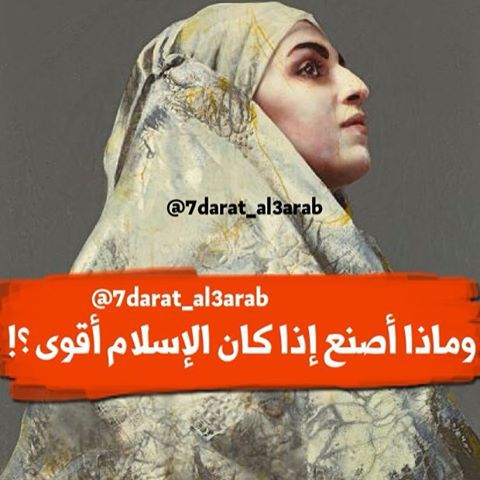Muuse Yuusuf
Monday September 26, 2016

In less than two months, the Federal Republic of Somalia will conduct indirect parliamentary elections, and 375 lawmakers will be elected by around 14,000 voters drawn from clan-based constituencies. Also, an Upper House of 54 representatives to be appointed by the existing regional states of Puntland, Galmudug, Jubaland and South-western will be constituted. This election arrangement is evidence of the current government’s failure to hold direct general elections this year.
Opinions are deeply divided in this war torn country. Some analysts hail the forthcoming elections as a milestone towards future democratic representation based on one person one vote. They argue that although these are indirect elections and 99.9 percent of a population estimated at 12.000.000 will not be voting, the new process is much better than the previous ones in terms of electorate participation and legitimacy.
Traditional leaders in consultation with wider constituents of around 14,000 voters will elect lawmakers, and unlike previous elections in which it was easy to buy votes of 135 traditional leaders, this time it would be much harder for a candidate to bribe a large number of voters.
In their view, regional states’ participation gives legitimacy to the upcoming elections, for example appointing members of the Upper House, as each sitting parliamentarian represent their clan constituencies. In short, democratic participation is getting closer to voters at grassroot levels. Unlike last time, election decisions will be made not only in Mogadishu but in Garowe, Baydhabo, Cadaado and Kismayo
However, other analysts dismiss the forthcoming elections as a corruption-ridden exercise where votes will be up for the highest bidder. The few thousand clan-based voters will be more likely a bunch of hand-picked characters with no morals, but with huge appetite for kickbacks. Furthermore, members sitting in regional states’ “parliaments” are no more than self-selecting characters appointed by “traditional elders” in a broken country where the number of “traditional elders” has multiplied since 1991, and the term has become synonymous with self-enrichment.
They argue that the current government has failed to conduct nation-wide census and the provisional constitution has not been put to a referendum and remains incomplete. Hence the legality of these elections is questionable because they will be based on an invalid document.
Besides that, there are no effective organised opposition groups to contest in the elections. Those purporting to be political parties are no more than one man’s project with no tangible constituencies and no legal framework or organisational structure, e.g. constitution, office etc. To put it blunt, these “opposition parties” are the outcome of one-night party fever held in Washington or Mogadishu and organised by ambitious individuals from the diaspora to launch “political party.” The launching ceremonies were attended and blessed by a handful of party-goers. Thus “opposition parties” are not formidable groups that can challenge a bunch of self-serving factions with vested interest in the existing governance structure who are determined to secure jobs in any future government and parliament. To them, the outcome of the approaching elections is foregone conclusion: a recycled parliament with the same old faces plus a few hand-picked characters.
They quite rightly point to the marked absence of Somaliland from the process, and argue that those “traditional elders” purporting to represent clan constituencies in the break away region are no more than charlatans with no legitimacy on the ground. They contest that genuine traditional leaders are in Somaliland, which held several direct elections.
Understandably and as regional stability and security depends on stable Somalia, the eyes of the international community and Somalis are focussed on the upcoming fateful events and are wary of the country’s future.
Perhaps with nostalgia, the more I look at the current debates around the approaching elections the more I feel tempted to seek lessons from the country’s modern electioneering history from 1950 in order to compare differences and similarities, and also to find out if there are any lessons that can be learned.
Therefore, it would only be fair to give the young and those not familiar with Somali history a brief historical background on the country’s elections.
It was March 1954 when, under the iron fist of the Italian colonial power, the first municipal elections for towns and cities were held in the Italian Somali colony, which was under UN-sponsored trusteeship managed by Italy. Conducted under the direct male suffrage system about 16 parties contested for 281 seats in 35 councils. Seventy five percent of the electorate voted and as expected the Somali Youth League (SYL) won most seats followed by Hizbia Dustur Mustquil Somalia (HDMS) party, which came second.
It is important to note here that this was the first time in modern Somali history that direct political participation was allowed because prior to this point Italian colonial administrations had appointed candidates for the municipal councils they created.
However, for the sake of clarity, it must be noted here that there is a long tradition of Somali clans electing their political leaders in a democratic way though under the direct male suffrage rule.
As the country moved with time, in February 1956, the first pre-independence general elections in the Italian colony was held. Again about 20 parties competed for the 70 seats of a legislative assembly, which was meant to replace Administrazione Fiduciara Italiana della Somalia (AFIS), the highest Italian authority in the country. However, only four main parties including the SYL, HDMS won seats in the parliament. And as we know on 9 May 1956, Abdullahi Isse Mohamud was appointed as the pre-independence first prime minister of Somalia.
As the country was being Somalized and power transferred to Somalis, the new legislative body was given full legislative authority over domestic matters, but control of foreign affairs and financial matters remained with the Italians who also had the power to overrule the assembly. The second pre-independence general elections, dominated again by SYL after other parties boycotted, followed on 4 March 1959.
In the north, the first pre-independence legislative council in the British Somaliland colony was formed in 1957. This was followed by the second pre-independence general election held in February 1960 and a new legislative assembly was elected. Political parties, such as the Somali National League (SNL) and the United Somali Party (USP) won all 33 seats except one seat. Mohamed Ibrahim Egal was appointed head of a four-man government. The assembly passed a resolution, which called for independence and unification of the colony with the Italian colony in July 1960.
On 16-22 April 1960, Somali leaders of the British and Italian colonies met in Mogadishu and proclaimed union of their territories. British Somaliland colony gained its independence on 26 June 1960 and merged with the Italian colony on 1 July 1960 hence the birth of the first modern Somali state: the Republic of Somalia.
Immediately after the act of the union, the two parliaments of the former colonies met again in Mogadishu on 1 July 1960 and formed the first post-union parliament. In order to lay strong foundations for the nascent Republic, citizens went to the polls again on 20 June 1961 to approve the first constitution. The outcome was clearly in favour of the constitution, as 1,760,530 citizens voted for it while only 82,987 rejected. The parliament elected Aden Abdulle Osman president for 6 years, defeating Sheikh Ali Jumale Baraale by one vote. Abdirashid Ali Sharmarke, leader of the Somali Youth League (SYL), was appointed prime minister.
From there on, several elections were held, including the first post-independence municipal elections in November 1963, the first and second post-independence national elections held on 30 March 1964 and June 1967 respectively. Again SYL dominated the process and won most of the seats. President in 1964, Aden Abdulle Osman appointed Abdirazak Hagi Hussein as prime minister instead of the then incumbent Prime Minister Abdirashid Ali Sharmarke, who was eventually elected president in the 1967 elections who then appointed Mohamed Ibrahim Egal as his prime minister.
The proud Republic’s experimental multi-party democracy, though imperfect and full of allegations of clanism, corruption and vote-rigging, ended prematurely on 15 October 1969 with the assassination of President Sharmarke by one of his body-guards while visiting Las Anod in the Sool region.
The military regime, which overthrew the civilian government, did organise direct elections under one party system after it had founded the Somali Revolutionary Socialist Party (SRSP) in 1976. In August 1979, a referendum was held and the second Somali constitution was approved by 3,597,692 votes, while only 7,898 rejected. The late Major General Siyad Barre was elected president in December 1979, and again in 1986 after winning over 99.9 percent of the casted votes!!
Since the collapse of the central government in 1991, the only significant direct elections worth mentioning were elections held by Somaliland. All others held in south-central Somalia were indirect elections, or if you like to call them a “selection exercise” under which a handful of traditional elders appointed lawmakers.
Now let me stop that brief historical narrative and return to the current realities on the ground.
Let alone comparing them with the national elections in 1950s and 1960s, if the current elections, be regional or national, are compared to the 1954 pre-independence municipal elections they are less democratic and lack legitimacy. Indeed, while the 1954 municipal councillors were elected directly by voters, today’s overlapping and growing “parliaments” are the product of a selection exercise by traditional leaders who hand-pick candidates. Though called “parliaments” with a government headed by a “president”, current regional or federal institutions are realistically no more than un-elected local authority councils headed by mayors.
If the argument against the 1954 municipal elections is that they were held under duress by a brutal colonial power and the country was not politically independent, the presence of around 20,000 soldiers in south-central Somalia sanctioned by IGAD/AU/UN only makes one to wonder whether the country is really politically independent. Indeed, political interference by the UN and other global and regional actors is well known. For example, as we all know the country was occupied by Ethiopia forces in 2007 until they were evicted by Somali nationalists.
Deep down in their hearts, many Somalis feel their country is under direct UN trusteeship in which IGAD/AU/UN representatives with their vested interest are shaping the future of this broken country. For example, regional states have dominated and controlled the different stages of the reconciliation process. Indeed, many Somalis believe that the process of federalism is a conspiracy by foreign powers (Ethiopia & Kenya), which are interested in the break up and balkanisation of Somalia. They are scared of strong and united Somalia for historical reasons.
To put it differently, if yesterday’s Somalia of 1954 was under the direct hegemony of the Italian colonial power through its AFIS supervised by the UN, it would not be unfair to describe Somalia of today as a country under the indirect rule of IGAD/AU sanctioned by the UN Security Council. With no credible and reliable national army capable of securing national security and stability, the current power arrangement, federal or otherwise, will probably collapse if AMISOM troops were to leave tomorrow hence anarchy or Al Shabaab will take over the rein.
Financially, as the government is broke, the cost of the previous and forthcoming elections was being paid by the international community. For instance, the European Union is paying AMISOM troops, which will provide security during the forthcoming elections exactly as Italians would have paid for the police force used to secure the 1954 municipal elections!
I hate to say this, but the current situation reminds me of scenarios in 1950s when Italian colonial administrations, using traditional leaders (capo cabile), appointed members of municipal councils. The only difference today is that it is a few hundreds of political elites, under pressure from regional and global actors, who are selecting members of their numerous “parliaments” that are merely un-elected local government councils.
In conclusion let me share with you a political statement made by the late President Aden Abdulle Osman, as I believe it describes eloquently the point I am trying to make. Asked to compare the 1960 Somalia with post 1990 Somalia, the former president made it clear that they were incomparable and said:
“Somalia of 1960 was a united country. Today there is not even a single document archived. Somalia went backwards by 100 years… …Those fighting factions have killed, maimed or displaced the people they want to rule. Even animals and plants (country’s natural resources) have been destroyed…”
God save Somalia.
Muuse Yuusuf
London
Myuusuf3@hotmail.com


